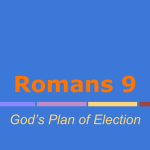John 6 is a favorite passage of Calvinists to demonstrate what they believe to be the truth about irresistible grace and unconditional election. In particular, John 6:44 seems to be the go-to proof text to demonstrate that all who are drawn by the Father will be saved (“raised up on the last day”). They see no possibility in the verse for an interpretation that posits some who are drawn by the father may actually resist his drawing (as Arminians have long held) and fail to be saved. This comes mainly because the same person who is drawn by the father is also the person in the next clause who is said to be raised up by Christ on the last day. In the Calvinistic understanding, drawing of the Father = salvation. I engaged a Calvinist friend of mine recently on this verse and sought to demonstrate that careful exegesis would not bear out this conclusion. Below is the response I offered him:
————————————————————————-
This verse has to be dealt with carefully as it is made up of three clauses. I will lay out the three clauses below with my translation so that we’re on the same page as I move through the exegesis:
1) οὐδεὶς δύναται ἐλθεῖν πρός με (No one is able to come to me)
2) ἐὰν μὴ ὁ πατὴρ ὁ πέμψας με ἑλκύσῃ αὐτόν (except the father who sent me draws him)
3) κἀγὼ ἀναστήσω αὐτὸν ἐν τῇ ἐσχάτῃ ἡμέρᾳ. (and I will raise him up on the final day.)
First, you are correct to point out the connection between clauses 1-2 and 3 of John 6:44. The pronouns appear in Greek just as they appear in the English translation and the point you are emphasizing is seen like this, “No one can come to me unless the Father who sent me draws HIM, and I will raise HIM up on the last day” (ESV). If the HIM (αὐτόν) is the same in both clauses 2-3, and it’s fairly clear that it is, then there leaves little room for doubt that the one drawn by the Father is the one raised up, and it might appear, then, that anyone who is drawn will most certainly be raised up by Christ. This is how I understand you and the traditional Calvinistic interpretation. It leaves no room to say that one drawn may not come. That is unless there is more packed in by implication to the identity of the HIM (αὐτόν) of clause 2, and I would argue that there is.
Before we move on to what is being said about the person in clause number 3, we have to clearly define who the person actually is (from clauses 1-2). From the outset in clause 1, we have the statement by Jesus, οὐδεὶς δύναται ἐλθεῖν πρός με (no one is able to come to me). The first emphasis, then, lies in the act of coming to Jesus and the natural inability of a person to do so. But yet, hope is offered in clause 2 because the drawing of the Father does what? Does it cause the person to come to Christ? Or, does it make the impossibility of clause 1 possible? All we can safely conclude from the grammar is the latter. So, if the drawing of clause 2, ἐὰν μὴ ὁ πατὴρ ὁ πέμψας με ἑλκύσῃ αὐτόν (except the father who sent me draws him), is connected as a dependent clause with clause 1, then the logical consequent is that the drawing of the father makes one who was formerly unable now able to come to Christ. And what does this tell us now about the identity of HIM? Thus far, without venturing into clause 3, all we logically know about the identity of the person described is that this person has been enabled to come. So, if we follow the logic you have communicated (and you’re in good company because it’s communicated by most Calvinists), then the person enabled to come will be raised up in the last day.
A Calvinist might then rightly point out, “Well, of course, the one who was raised up in the last day is not just enabled to come but also comes.” And I would agree, except for that interpretation cannot be inferred from the grammar of this verse alone. The only thing that can be inferred is that the one enabled to come is raised up, and I wouldn’t be so quick to equate enabling with the act one is enabled to do. So, are we then in danger of falling into some sort of universalist interpretation in which some enabled will be raised up whether they actually come or not? No, because the rest of the context of the section indicates other conditions than just being enabled to come. For instance, v. 40 states, “For this is the will of my Father, that everyone who looks on the Son and believes in him should have eternal life, and I will raise him up on the last day” (ESV). Thus, we know that belief is a necessary condition, not just being enabled to come. All of this leads me to the conclusion that the HIM in v. 44 carries the identity of one who was enabled to come and actually did come through belief. But if I took it in the simplistic sense without going anywhere else for context to find the identity of HIM, then I would only conclude that all who are drawn are enabled to and are raised up, not that they necessarily come. I point this out to illustrate that more context is needed than just the simple “HIM…HIM” of connection of clauses 2 and 3 to determine who is actually raised up in the last day, and we can’t simply assume, as I argued above, that drawing will necessarily equal coming. But from the surrounding context, we CAN safely assume that all who are raised up have been drawn and have come to Christ.





